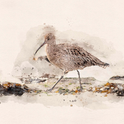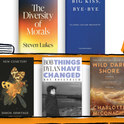In 1987, the feminist publishing house Virago published a collection of stories featuring British Asian girls caught in the conflicting demands of home and school. The author of Down the Road, Worlds Away was a 38-year-old mother of two called Rahila Khan, whose fiction had already been aired on Radio 4. “With hard-eyed realism and poignant simplicity,” the book’s blurb read, “Rahila Khan brilliantly gives voice to uneasy youth.” Virago’s remit, as Lennie Goodings puts it in A Bite of the Apple, was “to publish the stories of women’s everyday lives, stories previously not thought worth telling and recording,” and these tales perfectly fitted the bill.
The problem was that Rahila Khan did not exist. The author of Down the Road, Worlds Away was in reality an Anglican vicar called Toby Forward impersonating an Asian woman. He practised this deception, he said, because vicars were considered sitcom characters and he wanted to be taken more seriously. Forward decided “to let Virago know what had happened and to trust to their good sense, good business and basic humanity,” as he wrote in a confession piece in the London Review of Books. Goodings, who recently stepped down as Virago’s boss after 40 years with the firm, devotes two pages of her buoyant memoir to the fiasco.
“Outraged” by the deception, Goodings ordered all remaining copies of Forward’s stories to be pulped. “I now see this was a little extreme,” she writes. “We could probably have laughed it off—and then pulped his book.” The scandal, which created much hilarity in the press, fed the nation’s anti-feminism and belittled the urgency of Virago’s larger project. But it also stimulated genuine discussion. “Aside from thoughts on racism, lies, and feminism,” Goodings recalls, “a conversation and questions about the text emerged.”
“Does it matter who wrote it if a book is good? Our answer: well, it also depends how you are presenting the book. Question: what about the Brontës—they published under false, male names? Answer: they had to. Question: can you tell the difference between male and female writing? Answer: no. Question: is it true that female writers of colour have an easier ride than white men in getting published? Answer: no, look around you. Question: did the Reverend Toby Forward have the last laugh on the feminists? Answer: nobody agrees on that one! Question: is it okay for a vicar to dissemble? Answer: hmmm...”
The encounter with Forward has proved prescient for current debates about fiction and identity politics. Thirty years after the voice of “Rahila Khan” was silenced, Lionel Shriver, making the keynote speech at the 2016 Brisbane Writers Festival, put on a sombrero in support of the students at Bowdoin College in Maine who, when they hosted a tequila party wearing sombreros, were found guilty of “cultural appropriation” without permission. If wearing a sombrero is a crime for the non-Mexican, asked Shriver, where does this leave the novelist whose job it is to “wear other peoples’ hats”? What is a novel if not an appropriation of someone else’s voice? Shriver then cited the case of the white British male, Chris Cleave, who wrote a novel called The Other Hand from the perspective of a 14-year-old Nigerian girl and was accused by an American reviewer of “identity theft.” The story of the (imaginary) girl, said the reviewer, was “not implicitly [Cleave’s] to tell.” But is it not the role of the novel, Shriver argued, to cross cultural boundaries?
Earlier this year this question was raised again, in relation to a much anticipated and hugely promoted novel about the Mexican migrant experience. The author of American Dirt, Jeanine Cummins, had already admitted that she would “never know the impotent rage of being profiled, or encounter institutionalised hurdles to success because of my skin or hair or name,” and had expressed her concerns about being a non-migrant, non-Mexican representing the voice of Mexican migrants. “I wished someone slightly browner than me would write it,” she said of her book and her critics, for whom American Dirt is “trauma porn,” that exploits Mexican suffering for profit, agree. (More than 100 writers penned an open letter to Oprah Winfrey imploring her to drop it as her book club selection.) Cummins’s publisher, Flatiron Books, cancelled her publicity tour and issued an apology for cultural insensitivity in the marketing of the book. Despite, or perhaps because of, the controversy, the novel got to number one on the New York Times bestseller list.
When Virago delivered their first list of books in 1975, a journalist wondered if they would be able to find enough titles by women for their second list. After they became successful, they were asked why—having made their point about a male-dominated literary world—they didn’t now shut up shop. The Telegraph wondered whether a feminist publishing house was “still needed” given that “female frontrunners in the bestselling and the literary stakes are no longer a novelty but the norm, rendering the positive discrimination of a women-only press at best obsolescent and arguably retrograde.” This point was repeated so often that Goodings calls one of her chapters: “Does any other successful publisher get asked constantly if they are still necessary?” Her answer is that the issue is no longer getting women published. The new hurdle is getting books by women to be read by men. The Irish novelist Anne Enright puts it like this: “If a man writes ‘The cat sat on the mat’ we are taken by the simplicity of his sentence structure, its toughness and precision… If, on the other hand, a woman writes ‘The cat sat on the mat,’ her concerns are clearly domestic, and sort of limiting.”
The most notorious of the missiles aimed at Virago was by Anthony Burgess in 1979. Reviewing their reissued edition of Dorothy Richardson’s Pilgrimage, Burgess conceded that while readers should be “grateful” for Virago’s “recovery of a great fictional masterpiece,” the name of the publisher—meaning “a shrew, a scold, an ill-tempered woman” and “a female warrior”—is “unlovely and aggressive… even for a militant feminist organisation, and it presides awkwardly over the reissue of a great roman fleuve which is too important to be associated with chauvinist sows.”
The history of Virago is the history of feminism in microcosm. It was born in 1973 when publishing houses were run by Oxbridge men, Britain entered the EEC, and NUM members were poised to go on strike. Change was happening—but not for women. Carmen Callil and Ursula Owen, two young editors, decided to address this gap by setting up a publishing house that would almost exclusively publish women. Their tiny office in Wardour Street became central to the debate between socialist feminists, radical feminists, revolutionary feminists, lesbian feminists, black feminists and liberal feminists.
“The feminist politics of the 1970s were complex,” Goodings writes, “and, like any social and political revolution, had many splinters,” but Virago did not “take a stand on what is the ‘right’ kind of feminism.” What these different groups had in common, their founders believed, was “a desire to be heard… Women felt they had been left out, not asked and not represented, even in socialist politics—or perhaps especially in socialist politics. It was to this eager audience that Virago and the other feminist organisations of the time launched themselves.”
And yet Virago’s launch title, Mary Chamberlain’s Fenwomen: Portrait of Women in an English Village, was hardly a tub-thumping call to action. Nor was their second non-fiction book, Nancy Friday’s now classic compendium of female sexual fantasies, My Secret Garden. Virago was not, Goodings points out, “genuinely alternative,” like other women’s presses such as Sheba and Onlywomen. Instead, it was a profit-making enterprise with a clear hierarchy, at the top of which were Callil and Owen.
Their arguments became legendary. Goodings joined a company in which “curt words, silences, and angry memos became a not exactly unusual part of everyday office life.” The source of the tension was “jealousy, opposing personalities, widely differing styles, money”—and also the future of the company. Like many small publishing houses, it was eventually absorbed by larger entities. In 1982 it became part of Chatto, Virago, Bodley Head and Cape before being sold in 1995 to Little, Brown, where it remains a successful imprint publishing Margaret Atwood and Marilynne Robinson, among others.
Virago’s commitment to women’s fiction is at the core of its values. Its Modern Classics series, launched in 1978 with Antonia White’s Frost in May, is one reason for their continued success. It’s hard now to imagine a bookcase without a row of dark-green spines. Virago—or, more specifically, Callil—rediscovered Vera Brittain’s Testament of Youth, the novels of Elizabeth Taylor, Elaine Dundy, Mary Renault, Janet Frame, Rebecca West, Edith Wharton, Willa Cather, Charlotte Perkins Gilman, Radclyffe Hall, Attia Hosain and Sylvia Townsend Warner.
In an article for the TLS in September 1980, Calill described how after reading English in the English department of Melbourne University, shaped by the influential Cambridge don FR Leavis, she “longed to put a bomb under Leavis’s agonisingly narrow selection of ‘great’ novelists.” This is exactly what she did: “It’s not too much to claim that Virago Modern Classics changed the course of English literary history,” said Margaret Drabble. Callil was every bit as audacious as Leavis in deciding which women novelists would make the cut in her own canon. “Below the Whipple line I will not go” became her mantra, referring to the popular interwar novelist Dorothy Whipple, whose prose she rightly considered dreadful.
“I love the fact that Virago has always been an interesting paradox,” Goodings writes, “a well-run business with its own status quo set up to change the status quo of the world.” The paradox of Virago includes the fact that they have not been averse to publishing men. HG Wells figures on their backlist, and in 1996 Diran Adebayo became their first contemporary male novelist.
Nor are their authors necessarily feminist. Rosamond Lehmann, whose renaissance began when she became a Virago Modern Classic, would have been appalled by the F-word and the Belgian novelist Marguerite Yourcenar, whose volumes of autobiography were posthumously published in the UK by Virago in the 1990s, specifically said that she didn’t want to be published by Virago “because they publish only women. It reminds me of ladies’ compartments in 19th-century trains, or of a ghetto.”
Virago’s aim, which now sounds modest, was to take women’s stories, lives and achievements away from the margins and place them in the centre, where they belonged. Having steered the company through the storms of second, third and fourth-wave feminism, Goodings—now Virago’s chair—agrees with one of publishers of the next generation, publishing director Ailah Ahmed, that feminism cannot just be for middle-class white women. Virago continues to mirror the evolving feminist movement, and like that movement it has achieved a great deal and almost nothing at all. A world in which every woman’s voice can be heard remains a long way off. “Why,” as Goodings puts it, “are men tone deaf?”
A Bite of the Apple: A Life with Books, Writers and Virago by Lennie Goodings is published by Oxford University Press (£16.99)

The new "Bite of the Apple" collection goes inside the history of Virago. Photo: Prospect composite
How Virago blew up the canon
Long before the current debates about diversity in publishing, one house was putting women writers on the map
March 2, 2020











